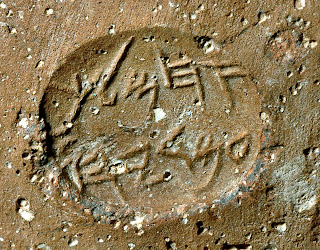
By MATTHEW KALMAN
JERUSALEM - The discovery of an ancient seal impression south of Jerusalem, announced on 23rd February by the Israel Antiquities Authority (IAA), has given an unexpected boost to the two men the IAA accuses of faking a series of priceless antiquities.
Oded Golan has been on trial since 2005 in the Jerusalem District Court, indicted on multiple counts of forgery, conspiracy and illegal antiquities trading.
Co-defendant Robert Deutsch is accused of a more minor role, selling some of the fakes to unwitting collectors.
Both men deny all the charges against them. Defence testimony by Professor Aldo Shemesh of the Weizmann Institute delivered on February 26th appeared to destroy much of the geo-chemical evidence presented by the prosecution.
One of the key exhibits in the case is a slim volume entitled “Forty New Ancient West Semitic Inscriptions,” written by Robert Deutsch and Professor Michael Heltzer of Haifa University. Its importance to the trial is the cover, which shows an inscribed decanter which the indictment accuses the defendants of faking in 2006 and selling it to millionaire collector Shlomo Moussaieff. The book was published in 2004.
 Seal impression of Ahimelek (son of) Amudiyahu, bought by Oded Golan from an antiquities dealer in the early 90s and published by Robert Deutsch in 1994
Seal impression of Ahimelek (son of) Amudiyahu, bought by Oded Golan from an antiquities dealer in the early 90s and published by Robert Deutsch in 1994But on pp31-33 of the same book there is a photograph and description of an ancient seal impression on the handle of a storage jar from the collection of principal defendant Oded Golan, with an inscription bearing the name Ahimelek (son of) Amudiyahu.
Robert Deutsch’s book containing Oded Golan’s unprovenanced seal impression, published in 1994
Golan says he bought the handle with the impression from an antiquities dealer in the Old City of Jerusalem in the early 1990s, but because it was not discovered in an authorized excavation, it is defined as “unprovenanced” and its authenticity might be doubted by some.
Then on February 23rd, the IAA announced its finds from an archeological excavation at Umm Tuba south of Jerusalem, in the ruins of a building dating to the reign of Hezekiah, King of Judah in the 8th century BCE – the period of the First Temple.
One of the IAA finds is a seal impression on the handle of a large jar that was used to store wine and oil in the royal compounds. It bears the seal of Ahimelek (son of) Amudiyahu, who was apparently a high-ranking royal official in King Hezekiah’s Court.
Seal impression of Ahimelek (son of) Amudiyahu, discovered in an Israel Antiquities Authority excavation at Umm Tuba, south of Jerusalem, February 2009
The name Ahimelek (son of) Amudiyahu does not appear anywhere in the Bible or any other written source. The name has been published only once before – in Robert Deutsch’s 1994 book.
So it appears that the storage jar found at Umm Tuba in February 2009 was impressed with the very same seal from Oded Golan’s collection and published by Robert Deutsch 15 years earlier.
Thanks to the IAA, there is now no doubt as to the authenticity of Golan’s seal impression. And, also thanks to the IAA, it has now increased perhaps tenfold in value.








